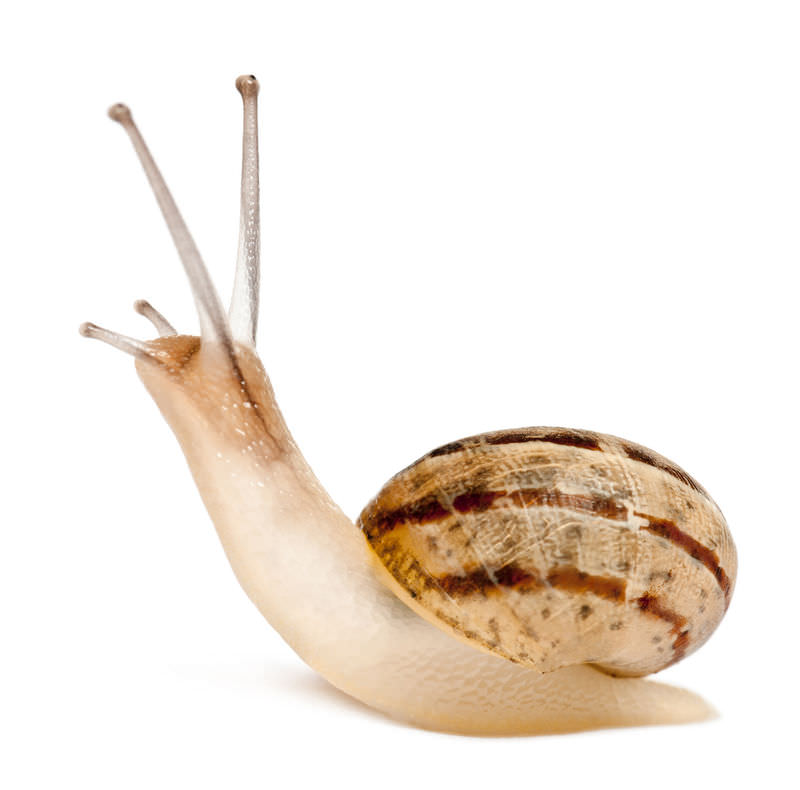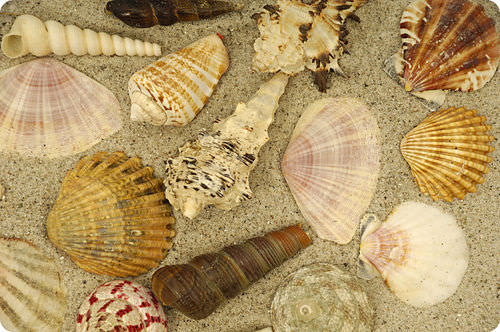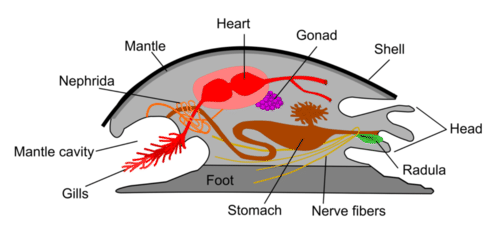9.7 软体
章节大纲
-
What does this snail have in common with a clam?
::这只蜗牛和蛤有什么共同点?You might notice that both have a shell. That is one feature of the group they both belong to, the mollusks. Mollusks are a very diverse group. They include animals that live on land and in the ocean. With well over 100,000 species , there can be a lot of shells.
::你可能会注意到两者都有壳。 这是它们都属于的动物群中的一个特征, 软体动物。 软体动物是一个非常不同的群体。 它们包括生活在陆地和海洋中的动物。 在超过10万种物种中, 可能有很多贝壳。What are Mollusks?
::什么是莫卢克斯?When you take a walk along a beach, what do you find there? Sand, the ocean, lots of sunlight. You may also find shells. The shells you find are most likely left by organisms in the phylum Mollusca . On the beach, you can find the shells of many different mollusks ( Figure ), including clams, mussels, scallops, oysters, and snails. Mollusks are invertebrates that usually have a hard shell, a mantle, and a radula . Their glossy pearls , mother of pearl, and abalone shells are like pieces of jewelry. Some mollusks, such as squid and octopus, do not have shells.
::当你在海滩上散步的时候,你会发现什么?沙,海洋,许多阳光,你也可以发现贝壳。你发现的贝壳,很可能是植物莫卢斯卡的有机体留下的。在海滩上,你能找到许多不同的软体动物(Figule)的贝壳,包括蛤、贝类、扇贝、牡蛎和蜗牛。摩卢斯是无脊椎动物,通常有坚硬的贝壳、人壳和。它们光滑的珍珠、珍珠之母和鲍鱼壳,就像珠宝一样。有些软体动物,例如鱿鱼和章鱼,没有贝壳。On the beach, you can find a wide variety of mollusk shells.
::在海滩上,你可以找到各种各样的软体动物壳。Features of the Mollusk
::Mollusk 的特征The Mollusk's body is often divided into different parts ( Figure ):
::Mollusk的尸体往往被分为不同的部分(图 ):-
A head with
or tentacles.
::头有或有触手。 -
In most species, a muscular foot, which helps the mollusk move. Some mollusks use the foot for burrowing into the sand, and others use it for jet-propulsion.
::在大多数物种中,肌肉脚有助于软体动物的移动。 有些软体动物用脚挖沙,另一些则用脚进行喷射。 -
A
mantle
, or fold of the outer skin lining the shell. The mantle often releases
calcium
carbonate, which creates an external shell, just like the ones you find on the beach. The shell is made of
chitin
, a tough, semitransparent substance.
::外壳,或外壳的折叠。外壳通常释放碳酸钙,产生外壳,就像在海滩上发现的一样。外壳是由坚硬的半透明物质,坚硬的金币制成的。 -
A mass housing the
organs
.
::大量存放器官 -
A complete digestive tract that begins at the mouth and runs to the anus.
::完全的消化道 从嘴开始 跑到肛门 -
Most ocean mollusks have a
gill
or gills to absorb oxygen from the water.
::大多数海洋软体动物都有一个或来吸收水中的氧气。 -
Many species have a feeding structure, the
radula
, found only in mollusks. The radula can be thought of as a "tongue-like" structure. The radula is made mostly of chitin. Types of radulae range from structures used to scrape
off of rocks to the
beaks
of squid and octopuses.
::许多物种都有一种喂养结构,即只存在于软体动物体内的萝卜。可以被视为一种“类似形”的结构。萝卜大多由 chitin 制成。萝卜的种类多种多样,从用来刮碎岩石的结构到鱿鱼和章鱼的嘴,不一而足。
This is the basic body plan of a mollusk. Note the mantle, gills, and radula. Keep in mind the basic body plan can differ slightly among the mollusks.
::这是软体动物的基本身体计划。 请注意 外壳、 和。 记住, 基本身体计划在软体动物之间可能略有不同 。Evolution of Mollusks
::Mollusks 进化Mollusks are probably most closely related to organisms in the phylum Annelida , also known as . This phylum includes the earthworm and leech . Scientists believe these two groups are related because, when they are in the early stage of development, they look very similar. Mollusks also share features of their organ systems with segmented worms. Unlike segmented worms, however, mollusks do not have body segmentation . The basic mollusk body shape is usually quite different as well.
::Mollusks可能与植物类Annelida(又称 ) 的有机体关系最为密切。这种植物类包括蚯蚓和。 科学家认为这两类生物是相关的, 因为它们处于早期发育阶段, 看上去非常相似。 Mollusks也与分解的蠕虫分享器官系统的特征。 但是, 与分解的蠕虫不同, 软体类动物没有身体分解。 基本的软体体形状通常也非常不同 。Summary
::摘要-
The mollusk body often has a head with tentacles, a muscular foot, a feeding organ called the radula, and a complete digestive tract.
::软体动物的身体通常有头部,有触手、肌肉脚、一种喂养器官,叫做萝卜,还有完整的消化道。 -
Mollusks have a mantle, which often secretes an external shell.
::Mollusks有一个壁炉, 它经常隐藏外壳。 -
Mollusks are most closely related to segmented worms.
::软体动物与分离的蠕虫关系最密切。
Explore More
::探索更多Use the resource below to answer the questions that follow.
::利用以下资源回答以下问题。-
Molluscs: The Survival Game
at
(15:08)
::软体:生存游戏(15:08)
-
How does the shell of the leafy hornmouth (
Ceratostoma foliatum
) help it against crushing predators?
::叶状角嘴(Ceratostoma folitum)的外壳如何帮助它对抗粉碎的掠食者? -
For what purpose do cockles use their foot?
::鹦鹉用脚有什么用? -
How and why do the radula of different mollusks vary?
::不同的软体动物的萝卜是如何和为什么变化的? -
For what purpose has the nautilus adapted its foot?
::纳图卢斯为了什么目的 调整了脚脚? -
What change in predatory fish behavior seems to have led to a squid body plan being advantageous over a nautiliod body plan?
::捕食性鱼类行为有什么变化 似乎导致鱿鱼身体计划 优于甲状腺体计划?
Review
::回顾-
What is a mollusk?
::什么是软体动物? -
Give three examples of mollusks.
::举三个软体动物的例子。 -
Describe three main characteristics of mollusks?
::描述软体动物的三个主要特征? -
What evidence shows that mollusks and segmented worms are related? How are they different?
::哪些证据表明软体动物和分离的蠕虫是相互关联的?它们有什么不同呢?
-
A head with
or tentacles.


